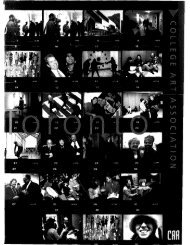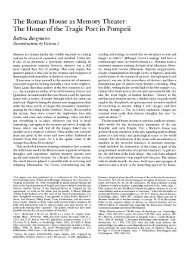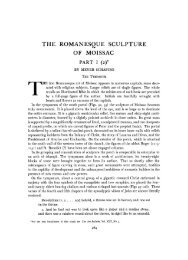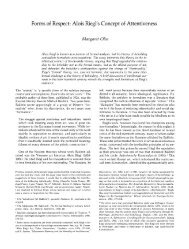THE HUMANISTIC THEORY OF PAINTING - College Art Association
THE HUMANISTIC THEORY OF PAINTING - College Art Association
THE HUMANISTIC THEORY OF PAINTING - College Art Association
You also want an ePaper? Increase the reach of your titles
YUMPU automatically turns print PDFs into web optimized ePapers that Google loves.
UT PICTURA POESIS: <strong>HUMANISTIC</strong> <strong>THE</strong>ORY <strong>OF</strong> <strong>PAINTING</strong> 235<br />
and since its effects on human emotion were the same, was subject to the same laws of<br />
decorum; and if it dealt with religious subjects, it had accordingly to be a categorically<br />
exact, as well as a vivid and moving, illustration of the facts of Christian history and the<br />
truths of theology. This specialized application of the Horatian concept did not outlast<br />
the Mannerist period, but it helped to encourage the view that persisted in the following<br />
century that decorum implied not only representative truth, but truth that was morally<br />
edifying as well. Herein for the seventeenth century, as for Horace, lay its connection with<br />
the precept that art should instruct as well as delight. In the preface to his Confirences<br />
de l'Acade'mie Felibien, for instance, regarded decorum (biense'ance) as "one of the most<br />
necessary elements in painting to instruct the ignorant, and one of the most agreeable in the<br />
eyes of the learned."'83<br />
That it might well be both is apparent from his remarks on decorum that immediately<br />
precede this thoroughly Horatian observation. For they reveal that close connection be-<br />
tween learning and the ability to render things with strict appropriateness already remarked<br />
in Gilio da Fabriano. "Decorum must be observed," writes Fdlibien, out-Horacing Horace,<br />
"in regard to ages, sexes, countries, different professions, manners and customs, passions,<br />
and usages of dress appropriate to each nation. Herein is Raphael admirable, but not so<br />
Titian and Veronese."'84 The formalistic implications of a passage like this-and one will<br />
immediately think of the aridly conventional gestures and expression of much French paint-<br />
ing of the late seventeenth century-are sufficiently obvious. It is clear, moreover, that if<br />
the artist is successfully to observe decorum in its diverse ramifications, he must get his<br />
facts straight about a great variety of men and nations, both ancient and modern; he must<br />
in short be possessed of a truly uncommon erudition. Hence it is that the critics frequently<br />
undertake to instruct the painters in what they must know if they are to be historical<br />
painters worthy of the name. What they tell them, often at great length, Boileau, instruct-<br />
ing the poet concerning decorum, sums up in three lines:<br />
Conservez ' chacun son propre caractere.<br />
Des siecles, des pais, etudiez les mceurs,<br />
Les climats font souvent les diverses humeurs.18<br />
VI-<strong>THE</strong> LEARNED PAINTER<br />
The theory of the learned painter, twin brother of the learned poet whose prototype was<br />
the doctus poeta of antiquity, was an important element in the doctrine ut pictura poesis.<br />
Furthermore it was an element of great vitality which, gathering girth and momentum in<br />
the sixteenth century, had hardly spent its energy by the end of the eighteenth. Yet as<br />
fashioned by the Italian critics of the Cinquecento, the learned painter is a highly theoretical<br />
personage who, if he cannot be called an actual figment of the imagination, has never had<br />
more than a partial basis in reality; and much of the time he has had no basis there at all.<br />
Now no sympathetic student of the Renaissance will quarrel with the view already expressed<br />
in the fifteenth century by Alberti that the painter will do well to know the poets and<br />
historians who will supply him with subjects of universal interest, and to associate with<br />
poets and learned men of his own day and age who may provide interesting ideas."'8 But<br />
when in the later sixteenth century it is also insisted-and critics of literature were giving<br />
the same advice to the poet-that the painter be learned not only in sacred and profane<br />
183. P. 317.<br />
184. Loc. cit.<br />
185. L'art po/tique, III, 113-I5.<br />
186. See Chapter II and notes 73 and 74.










